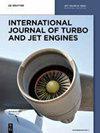可调速机匣端部位置对跨声速压气机转子叶尖泄漏流动的影响
IF 0.9
4区 工程技术
Q4 ENGINEERING, AEROSPACE
引用次数: 0
摘要
可控转速套管是一种新颖的套管处理方法,它使部分套管以可调的适当转速旋转,以达到稳定膨胀的目的。大量研究发现,套管处理的结构参数会影响扩稳效果。本文采用数值计算方法,研究了可控转速机匣中可旋转环端部位置对机匣叶尖泄漏流动和稳定膨胀的影响。结果表明:当可转环以30%和50%转子设计转速旋转时,无论末端位置在哪里,可调速机匣都能实现压气机转子的稳定膨胀;端部位置的上游运动降低了叶顶通道中后部的轴向压力梯度。它将激波推向下游,减少了叶顶前缘的堵塞区域。末端位置的上游运动有助于稳定运营边际的近似线性增长。本文章由计算机程序翻译,如有差异,请以英文原文为准。
Influence of the ending position of controllable speed casing on a transonic compressor rotor tip leakage flow
Abstract The controllable speed casing is a novel casing treatment approach that makes partial casing rotate at adjustable and proper speed to achieve stability expansion. Structural parameters of casing treatment are found to influence the effect of stability expansion by many studies. In this paper, the effect of the ending position of the rotatable ring in controllable speed casing on the tip leakage flow and the stability expansion was studied numerically. The results show that when the rotatable ring rotates at 30 % and 50 % rotor design speed, the controllable speed casing achieves the stability expansion of the compressor rotor no matter where the ending position is. The upstream movement of the ending position decreases the axial pressure gradient in the middle and rear of the tip passage. It pushes the shock wave downstream, which reduces blockage region at tip leading edge. The upstream movement of the ending position contributes to an approximately linear increase in the stable operating margin.
求助全文
通过发布文献求助,成功后即可免费获取论文全文。
去求助
来源期刊

International Journal of Turbo & Jet-Engines
工程技术-工程:宇航
CiteScore
1.90
自引率
11.10%
发文量
36
审稿时长
6 months
期刊介绍:
The Main aim and scope of this Journal is to help improve each separate components R&D and superimpose separated results to get integrated systems by striving to reach the overall advanced design and benefits by integrating: (a) Physics, Aero, and Stealth Thermodynamics in simulations by flying unmanned or manned prototypes supported by integrated Computer Simulations based on: (b) Component R&D of: (i) Turbo and Jet-Engines, (ii) Airframe, (iii) Helmet-Aiming-Systems and Ammunition based on: (c) Anticipated New Programs Missions based on (d) IMPROVED RELIABILITY, DURABILITY, ECONOMICS, TACTICS, STRATEGIES and EDUCATION in both the civil and military domains of Turbo and Jet Engines.
The International Journal of Turbo & Jet Engines is devoted to cutting edge research in theory and design of propagation of jet aircraft. It serves as an international publication organ for new ideas, insights and results from industry and academic research on thermodynamics, combustion, behavior of related materials at high temperatures, turbine and engine design, thrust vectoring and flight control as well as energy and environmental issues.
 求助内容:
求助内容: 应助结果提醒方式:
应助结果提醒方式:


